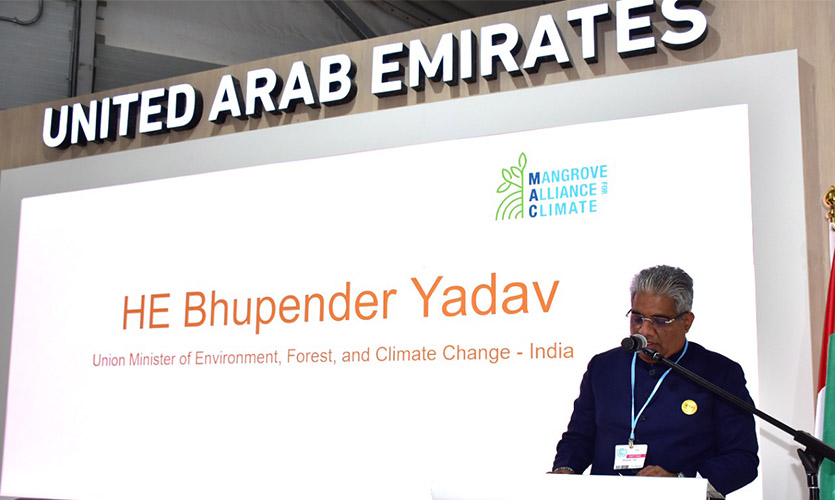India has joined the Mangrove Alliance for Climate (MAC) at the 27th Conference of the Parties (COP27) in Sharm el-Sheikh, Egypt. New Delhi will collaborate with Sri Lanka, Indonesia, and other countries to preserve and restore mangrove forests in the region, as part of its goal to increase its carbon sink. The Indian government has called for integrating mangrove conservation with the Reducing Emissions from Deforestation and Forest Degradation (REDD) programmes for sequestering carbon.
Bhupender Yadav, the Union Minister for Environment, Forestry, and Climate Change, had stated on Tuesday that India, which is home to the Sundarbans, one of the largest remaining mangroves in the world, and has years of experience restoring mangrove cover, could help other countries do the same.
MAC, an intergovernmental alliance dedicated to preserving and restoring mangrove ecosystems, seeks to expand and accelerate progress. As part of its mission, it aims to educate and spread awareness about mangroves’ role in curbing global warming, as well as their potential role in climate change mitigation. Apart from India, Australia, Japan, Spain, and Sri Lanka are among the first five nations to join the MAC.
At the launch of the alliance, the UAE’s Climate Change and Environment Minister Mariam bint Mohammed Almheiri announced that her country would plant 3 million mangroves by the end of the year, in line with its COP26 commitment to plant 100 million mangroves by 2030.
“Increasing reliance on nature-based solutions is an integral element of the UAE’s climate action on the domestic as well as international level, therefore, we seek to expand our mangrove cover,” she said, as per a report in Dubai-based news channel Al Arabiya. “We are pleased to launch MAC jointly with Indonesia, and believe it will go a long way in driving collective climate action and rehabilitating blue carbon ecosystems,” she added.
What Are Mangroves And How Are They Important To India’s Ecology?
A mangrove tree is a small tree or shrub that grows along the coast. A unique forest of these trees grows at the edge of the sea and the land in salty water. They can also be found in swamps. In order to survive, mangrove forests need low oxygen levels, and can withstand extreme weather conditions. Mangroves in West Bengal make up the largest forest in the world – the Sundarbans.
There is 10 times greater capacity of carbon storage in these forests per hectare, than in terrestrial forests. Despite this, they cover less than one percent of the earth’s surface, and are a natural barrier against the sea’s ravages. Additionally, mangrove ecosystems hold 80 percent of the world’s fish population, which benefits from their healthy growth. Their carbon storage capacity is 400 percent higher than that of land-based tropical rainforests.
Mangroves’ unique ability to capture and store carbon is increasingly catching the attention of the world, which is desperately looking for ways to keep the global temperature in check. South Asia’s mangrove cover is largely dominated by India. Approximately, 0.15 percent of the country’s total land area is covered by mangroves, according to the Forest Survey Report 2021 released in January, and 17 square kms have been added since 2019.
As a percentage of India’s land area, West Bengal has the highest amount of mangrove coverage, followed by Gujarat and the Andaman and Nicobar Islands. A number of other states, including Maharashtra, Odisha, Andhra Pradesh, Tamil Nadu, Goa and Kerala also have mangroves.
Despite this, infrastructural projects, industrial expansions, construction of roads and railways, and natural processes like coastal erosion and storms have caused a significant decline in mangrove habitats. In its 2022 report, the Global Mangrove Alliance reported that around 600 sq kms of mangroves were lost between 2010 and 2020. Of this loss, more than 62 percent was caused directly by human activity.
As per Union Minister Bhupender Yadav, who is representing India at the COP27, Indian officials are concentrating on concessional and climate-specific grants to drive climate finance. India has teamed up with Brazil, South Africa, and China (the BASIC bloc) to negotiate the same. During COP26, Prime Minister Narendra Modi announced that by 2030, the country will generate 500 GW of fossil fuels-free electricity, and meet half of its energy needs with renewable sources.
Read more: COP27 Agenda To Focus On ‘Loss And Damage’ Funding










